The Horse Is Now a 21st Century Thoroughbred
For almost 60 years the Ford Mustang has been an aspirational vehicle that created the “Pony Car†category, and has inspired countless individuals craving a sporty, fun-to-drive vehicle. Everyone has a story of how the “Horse†was a fun and fast part of their life.
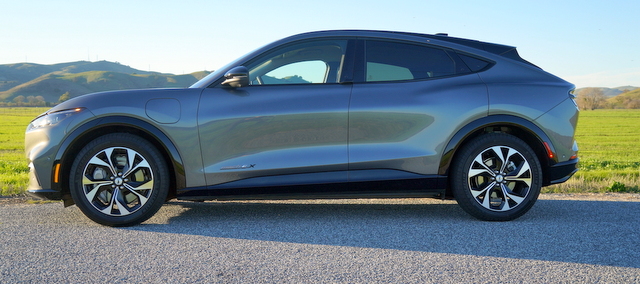
For 2021, Ford has expanded and evolved the Mustang line with the all-electric Mustang Mach-E SUV/crossover. Ford continues the Mustang tradition by offering a version for just about everyone, from an economy long-range budget version to a full-on performance vehicle with power and speed in the top-tier of supercars.
A Flexible EV with Lots of Configurations
For 2021, Ford offers a myriad of configurations:
•With an MSRP ranging between $42,895 for the Select trim and $60,500 for the GT, there are five trim levels to choose from. As has been the Mustang tradition, there is a Mustang Mach-E for everyone.
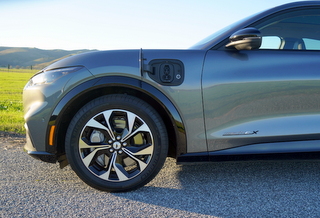
•Range choices include two battery packs to choose from with a 75.7-kilowatt-hour (kWh, of which 68 kWh is usable) standard range and 98.8-kWh (of which 88 kWh is usable) extended range version that offer ranges between 211 and 300 miles.
•There are three electric motor sizes ranging from 266 horsepower (hp)/ 317 pound-feet (lb.-ft.) of torque to 480 hp/600 lb.-ft. Torque.
•There are both RWD and AWD drivetrains available.
• Choose from 10 exterior colors and two interior colors
• Each trim is well-appointed with few options, and no upcharge for colors other than black.
Depending on the configuration, the Mach-E will accelerate from 0-60 mph between 3.5 and 6.1 seconds. Electric vehicles are known for being very heavy vehicles, and the Mach-E is no exception. It’s right up there with just about every manufacturer’s offerings weighing in at between 4,400 and 4,900 pounds. The good thing is that a significant amount of that weight is in the battery and is low in the center of the car, which makes it handle like a much lighter vehicle.
The Mach-E, a tall five-door fastback, sits on a 117.5-inch wheelbase, is 185.6 inches long, 74.1 wide, 64.0 high and has 5.8 inches of ground clearance. Even though it looks like a four-door sedan from a distance, it’s really a five-door SUV.
Cargo space is very good, mainly because the rear cargo exterior area is cleverly disguised to look like a fastback rather than its true squareback.
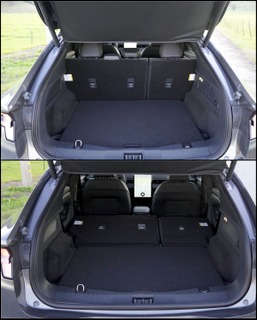
With the rear seats up, there is 29.7 cubic feet (cu. ft.) of space in the rear; with the rear seats down that increases by 30 cu. ft. for a total cargo area of 59.7 cu. ft. Add to that 4.7 cu. ft. in the frunk, and you have a total of 64.4 cu. ft. available. Towing packages are not yet available, but the Mach-E is expected to have a towing capacity between 1,500 and 2,000 pounds. All in all, the Mach-E interior spaces compete very well with its non-EV competitors from Toyota and Honda as well as its EV competitors.
The Mach-E benefits from Ford’s superb Co-Pilot360 Level 2 ADAS, including adaptive cruise control with stop and go capability, lane centering, forward collision avoidance and mitigation by braking and steering, and blind spot monitoring with steering support, to name a few. The Ford system is one of the better ones on the market today, with an easy and unobtrusive operation. One feature of the Mach-E system is the ability to offer “one-pedal†driving. The driver should anticipate when to lift the throttle, but once you get the hang of it, it’s a pretty awesome.
The Mach-E CA Route 1, Premium, First Edition and GT are prepared with the necessary hardware for Ford Co-Pilot 360 2.0, which is an active-drive system that allows hands-free driving on prequalified sections of divided highways that make up over 100,000 miles of North American roads.
Ford developed Active Drive Assist based on advanced computing of camera and radar-sensing technologies to provide real-time hands-free driving opportunities. The technology also enables expanded hands-free driving zones in the future based on system and customer patterns. The technology will become available as a subscription service in the third quarter of 2021 via an over-the-air (OTA) update, as part of Ford’s bumper-to-bumper OTA capability to help improve the Mustang over time and keep customers at the forefront of technology.
A Comfortable and Airy Cabin
At the end of the day, the comfort, safety and usability of the cabin is the most important attribute of any vehicle. How do the seats feel, are the instruments useful and intuitive, does the interior entertain and delight? On all of these attributes, the Mach-E does very well.
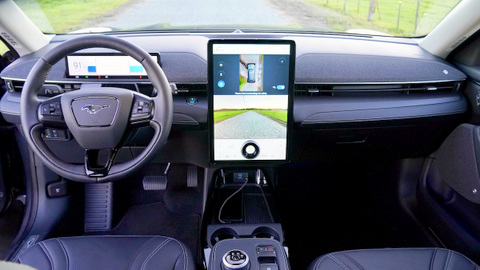
All that is needed for the driver is to have a “key†to operate the car. That Key can be a traditional fob that you keep in your pocket or purse, your smartphone, or even a combination lock on the B-pillar to unlock the Mustang with a password entered on the center display to give the driver complete control of the vehicle
If you are using the fob or your phone, simply walk up to the car, and it will recognize and welcome you with light show theatrics from the front and rear of the car. Press the door button and it unlocks and the car prepares itself to be ready for the driver to push the start button and go. The car is ready for you with all of the seat, mirror, infotainment presets, set to your preferences. There are two large screens, a 10.2-inch drivers information cluster, and a huge 15.5-inch center high-resolution display. Topping this off is an available 560w B&O (Bang&Olufsen) sound system with 10 speakers, including an externally coupled subwoofer that uses the Mach-E’s cabin volume to produce powerful bass.
The centerpiece of the cabin is the Mach-E’s 15.5-inch center high-resolution display for the infotainment and navigation. It’s similar to other big screen interfaces for cars and has an easy-to-learn interface that uses information panes to keep what you need available when needed. But instead of cramming all of the information for all of the car’s functions on one screen, there is a smaller 10.2-inch screen directly in front of the driver for driver centric information like warnings on battery capacity and range, speed, turn-by-turn navigation information and the readiness of the vehicle. It’s much like a head-up display (HUD), but presented in a cleaner and more compact view.
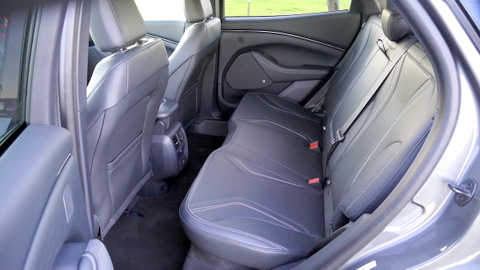
The interior is topped with a full width glass roof, which makes the interior open and airy, and the glass has a special coating that prevents the interior from getting hot from the sun. The full glass roof also opens up extra headroom especially in the rear. Despite the entire interior roof being glass, we were never distracted by glare or heat. After a while the glass roof isn’t even noticed. Glass roofs seem to be the fad these days rather than a steel one or a moveable sunroof. It’s a nice design treatment, and works quite well in the Mach-E
Build quality of our Mach-E tester was fantastic, not a rattle, creak, or squeak was heard, window sealing was awesome with minimal wind noise. The suspension was well dampened so road noise was stopped before it got inside the cabin, which made the wind noise that did make it into the cabin all the more noticeable. The solution to this minor irritant was to simply crank up the B&O sound system.
The suspension of our test Mach-E was the Premium RWD extended range version with the 88-kWh battery. Its road manners were quite subdued, with a bit of wallowing on windy roads, but for freeway and city driving, this was the perfect setup.
Driving–How Is It Like on the Road, How Far Will It Go on a Charge?
Today’s BEVs have gained significant range in the past few years, due to the combination of cheaper batteries, higher energy efficiency, and better technology. This is Ford’s first purpose-built BEV, and they seem to have given the issue of range serious thought.
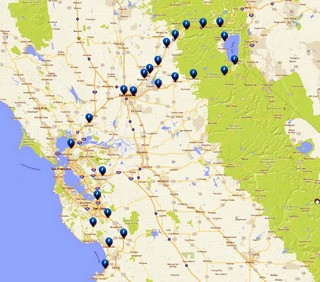
We wanted to see how the Mustang Mach-E would perform on our challenging BEV test loop, which is a 228-mile trip (456-mile round trip) from San Jose Ca. to South Lake Tahoe. This route starts at sea level, and includes a 7,377-foot (ft.) pass before settling in at 6,327 ft. in South Lake Tahoe. Essentially, it’s interstate flatland roads for half the trip and up and over one of the highest mountain road passes in the Sierra Nevada mountain range. Over the years that we have tested BEVs on this route, most have come up short in reaching the final destination, usually by between 10 and 30 miles in each direction. The Mach-E that we were driving was the 88-kWh RWD extended range version that boasted an EPA range of 300 miles Would it be one of the few to make it to our Lake Tahoe destination on one charge? And what sort of energy efficiency would it return?
The Mach-E has quirky drive mode descriptions. These modes, called Engage, Whisper and Unbridled, are essentially the Mach-E’s version of Economy, Normal and Sport. They adjust not only the powertrain response, but steering, instrument cluster graphics, handling and interior synthetic sounds for acceleration. We chose to use the Whisper mode for the uphill part of our trip and Engage for the downhill return trip.
FordPass, North America’s Largest Charging Network
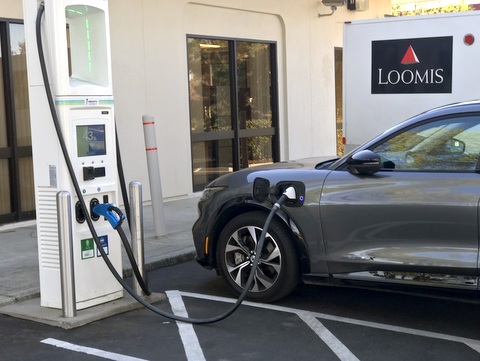
To make charging easier, Ford includes a smartphone app called FordPass Connect, which is also accessible from the vehicle’s main display. Ford has created a private-label charging network by collaborating with Electrify America, EVgo, Greenlots and Chargepoint. FordPass Connect provides a unified user experience to find chargers, plan trips, and monitor the Mach-E’s state of charge, and identifying charging points along the route at more than 12,000 locations with access to 35,000 charging stalls. If the charging station has the ability to identify and provide conditional access, all the driver has to do is to plug-in the charger to the car, and authentication, billing, etc., is handled automatically. For other types of charging stations, the FordPass connect takes care of setting up the session without having to have a card or app for that particular charging provider. When we charged up the night before the trip, all we had to do was plug in the Mach-E, and the details were taken care of automatically. Ford includes two-years of complimentary access to the FordPass charging network, which is currently North America’s largest charging network.
The Mustang Mach-E has the ability to charge at up to 150 kW L3 charger and 11 kW on a L2 charger.
Preparing for the Drive
We started the night before charging the Mustang Mach-E at our local FordPass/Electrify America CCS 150-kW charger for about 40 minutes. The car had 37 percent charge on it when we started the charge and ended up with an 83 percent SOC.
The charger started off at 125 kW and tapered down significantly to 11 kW at the end. That evening we topped-off on our L2 6.6-kW charger at home so we had 100 percent available in the morning. Part of the range estimation is how the car was driven previously, so we started out with an estimated 276 miles of range. More than enough if we were driving on flat terrain, but how would it do on terrain ranging from sea level to 7,377 ft.?
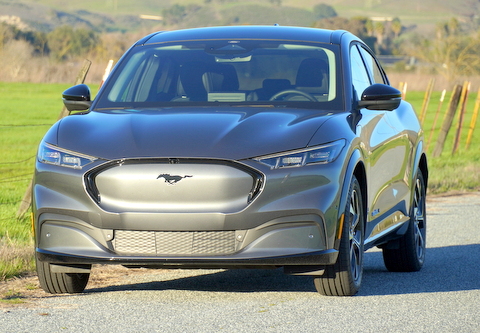
Our route took us 126 miles on Interstate 5 to Sacramento. This section of the trip is pretty flat except for two hills we had to cross, so we stayed with traffic at about 70 mph. Once we were east of Sacramento we switched to Highway 50 and started our climb into the Sierra and Lake Tahoe. This section is a steep uphill climb. Despite our slower speeds, the Mach-E’s SOC was holding steady.
The nice thing about this section of Highway 50 is that there are EVgo fast chargers about every 40 miles, and in past tests of BEVs that had 78 kWh batteries, we were never able to make it all the way to Lake Tahoe on one charge. We were always 10-30 miles short.
The Mach-E seemed to be taking the climb in stride in normal mode with climate control on and keeping at the speed limit. By the time we got close to Pollock Pines and 181 miles into the trip, we were down to 70 miles of range left, with 47 miles to go. We decided to continue on knowing that we had one last chance to charge in 30 miles at an EVgo station. After that we were really committed.
We passed the last 50 kW EVgo quick charger before Lake Tahoe with 40 miles of range indicated, and knew that we would be able to make it. The summit was less than five miles away; after that, it was all downhill to Lake Tahoe. We cruised to our hotel with 11 percent SOC and 24 miles range left.
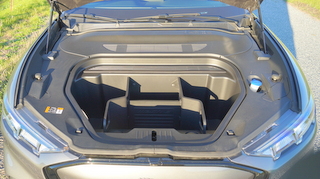
For this uphill portion of our trip that day we ended up driving 225 miles with an energy efficiency of 3.1 miles/kWh. This was a great result for such a heavy car going uphill, and one of the better returns. The total of actual and remaining estimated miles, came out to 249 miles for the uphill drive. The Mach-E has a nifty energy analysis screen called “Where did my energy go?,†which showed that 89 percent of the car’s battery went to the route and the rest went to the climate control, accessories, and dealing with the ambient temperature. This estimating tool would come in handy for the downhill drive.
In preparation for our downhill drive, we used an Electrify America charger that was less than a block from our hotel, and ran into a little bit of a problem with getting the chargers to connect. Two pedestals would not connect because of a reported ground-fault error, but the 3rd one did fine. Just plug it in, and FordPass Connect took care of the rest. The Mach-E charged for 40 minutes starting at 125 kW and ending at 11 kW, and we got a SOC of about 78 percent. There was also a free L2 charger at the library next to our hotel, so that evening we let the car sit there all day to fill back up. It took about six hours to get charged to 100 percent, and the ambient temperature was down to 30ËšF. But something was up because even though the SOC was 100 percent, the estimated range was only 180 miles.
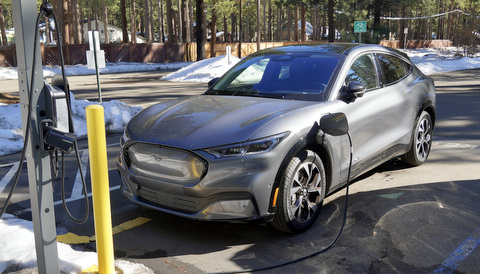
That evening the low temperature at Tahoe was 10˚F, but by the time we were ready to go the next morning, it had risen to 21˚, but the estimated range was still estimated at 180 miles. What was going on here? Would we be able to make it back on one charge even going downhill? For the downhill run, we chose the “Engage†or Economy drive mode.
The “Where did my energy go?†screen on the Mach-E gave us a clue to this situation. The estimation of battery usage had allocated 57 percent of the battery to climate use given it was so cold in Tahoe and 43 percent to the route. The Mach-E does not use a heat pump for climate control, and instead uses resistance heating for both the cabin and battery temperature controls, which resulted in the lousy range estimate. We hoped that as we went downhill into the Sacramento Valley that the range would improve. We added a lunch stop in Sacramento at a bit before the halfway point to reassess the situation.
As we started back down into the flatlands, we had the adaptive cruise control set, and let the car drive, steer and brake itself. Initially, the Mach-E restricted its regenerative braking, but as the temperature got warmer in the lower elevations, it used the friction brakes less and regen more. But even more interesting is that the estimated 180 miles of range didn’t budge as we got closer to Sacramento. But what did change was how the car was estimating its energy usage. The ambient temperature had gone from 21˚ to 69˚; climate usage dropped from 57 percent to seven percent, and the route power utilization jumped from 43 percent to 91 percent.
By then we were pretty confident that we would be able to make it home on one charge with miles to spare. For this section, we ended up driving 225 miles from Tahoe to San Jose, with an energy efficiency of 4.1 miles/kWh. That’s pretty good, but not as good as high-efficiency BEVs like the Nissan Leaf Plus.
We went across the finish line with a 36 percent SOC and 88 estimated miles of range left. This trip gave the Mach-E a total range of 313 miles. The average efficiency for the round-trip was 3.6 miles/kWh and estimated range was 281 miles, which was the estimated range when we left on the trip. This was a very respectable efficiency and in the top tier range of all BEVs on the market today.
Ford Mustang Mach-E MSRP Pricing
Our evaluation vehicle was a Mach-E Premium RWD Extended Range with an MSRP of $53,100.
There are currently four versions of the Mustang Mach-E available today:
Mach-E Select RWD Standard Range: $42,895
Mach-E Select AWD Standard Range: $45,595
Comfort /Appearance Package: $2,300
Destination & Delivery: $1,100
Mach-E Premium RWD Standard Range: $47,000
Mach-E Premium AWD Standard Range: $49,700
Mach-E Premium RWD Extended Range: $52,000
Mach-E Premium AWD Extended Range: $54,700
Interior Protection Package: $240
Destination & Delivery: $1,100
Mach-E California Route 1 RWD Extended Range: $49,800
Interior Protection Package: $240
Destination & Delivery: $1,100

Mach-E GT AWD Extended Range $60,500
Interior Protection Package: $240
Destination & Delivery: $1,100
(currently available for reservation only)
Is the 2021 Mustang Mach-E Right for You?
In the $40-60,000 BEV price range there are several good choices, but all of them have their shortcomings. The Mustang Mach-E is a new player to the game; they have done their homework very well for their initial offering, with plenty of room to grow. If you are considering a high-quality SUV EV, then the Mustang should be at the top of your consideration list.
What We Took Note of:
•The Mach-E is a very heavy car with class-leading battery sizes and ranges. While its suspension is well designed for the cars heft, the batteries’ usable range isn’t fully utilized at launch. It would seem logical that as Ford gets more real-world data from the worldwide fleet, it would be able to open up more of the battery for increased range.
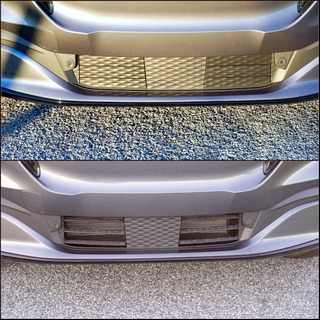
•The Mach-E uses a simple resistance heater for cabin temperature control, which as we saw at freezing temperatures severely limited the car’s range. Moving to a heat-pump based HVAC system would help improve range efficiency at low temperatures. This isn’t a big deal if you live in southern climates, but would certainly be an advantage for those that live in the northern areas of the world.
•The center infotainment stack is a great combination of digital and analog controls with just the right balance of touchscreen buttons and actual buttons and knobs. The Mustang also has voice control, but it is very primitive, knowing only limited commands that need to be spoken precisely with a proper syntax to operate. It has a way to go to become a natural language interface.
•The Mach-E only comes with one key fob standard. If you want two fobs, you have to pay for the second one. That seemed weird, but Ford counters that your smartphone can become a key and the driver can set up the B-pillar keypad up to access the vehicle too. To add insult to injury, the one key fob that comes with the car doesn’t have a button to release the frunk. If you want that opened, you have to use the release lever in the drivers footwell.
• While we are in the frunk, there is this divider cutting up the spacious storage area into several smaller ones. Ford explains that the divider has something to do with a federal regulation, but like mattress labels whose removal is prohibited by law, this divider is easily removed.
What We Did Love About the Car Included:
•Fit and finish. The Mach-E is a very well assembled car. We found a very tight vehicle with no squeaks or rattles, and very consistent panel gaps.
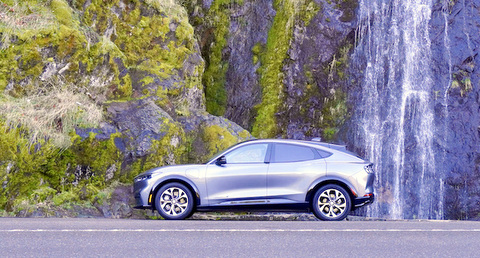
•Driving feel and balance. Despite being a very heavy car, the balance of the vehicle on the road was excellent. With the low center of gravity and balance between wheels it was a joy to drive with a neutral feel. Some might want a bit more aggressive handling, and that will be available in the GT variant.
• A very driver-friendly cabin. The center screen has the things that should be there, and the driver’s display has the things that a driver needs to be aware of. The UI of the center display takes a minimal time to get used to, and becomes very intuitive in a short time.

•The Co-Pilot360 L2 ADAS is very easy-to-use and takes its tasks to hand very safely and intuitively. With its upcoming OTA upgrade to a subscription full self-driving service on some roads this summer, it is set to become one of the best ADAS systems on the market today.
• Lastly, would your humble automobile reviewer consider spending his hard-earned cash on the Mustang Mach-E? The answer is yes; I’ve been driving BEVs for more than a decade, and am currently in the consideration phase for my next BEV. The Mach-E is on my shortlist of cars that include others from Stuttgart, Cuautitlán, Ingolstadt, Wolfsburg and Oppama.
Story & photos by Gary Lieber.
Make sure to opt-in to the Clean Fleet Report newsletter (top right of page) to be notified of all new stories and vehicle reviews.
Related Stories You Might Enjoy—Other Electric Road Trips
Road Trip: 2021 Polestar 2
Road Trip: 2020 Nissan Leaf
Some more Clean Fleet Report takes on the Mustang Mach-E
Road Test: 2021 Ford Mustang Mach-E (Steve’s take)
Flash Drive: 2021 Ford Mustang Mach-E (John’s take)
Disclosure:
Clean Fleet Report is loaned free test vehicles from automakers to evaluate, typically for a week at a time. Our road tests are based on this one-week drive of a new vehicle. Because of this we don’t address issues such as long-term reliability or total cost of ownership. In addition, we are often invited to manufacturer events highlighting new vehicles or technology. As part of these events we may be offered free transportation, lodging or meals. We do our best to present our unvarnished evaluations of vehicles and news irrespective of these inducements.
Our focus is on vehicles that offer the best fuel economy in their class, which leads us to emphasize electric cars, plug-in hybrids, hybrids and diesels. We also feature those efficient gas-powered vehicles that are among the top mpg vehicles in their class. In addition, we aim to offer reviews and news on advanced technology and the alternative fuel vehicle market. We welcome any feedback from vehicle owners and are dedicated to providing a forum for alternative viewpoints. Please let us know your views at publisher@cleanfleetreport.com.

30 thoughts on “Road Trip: 2021 Ford Mustang Mach-E”